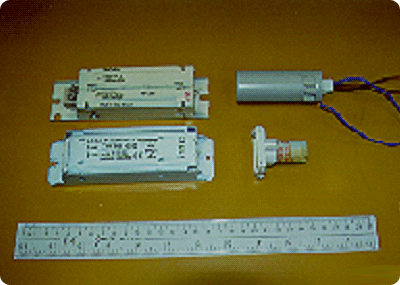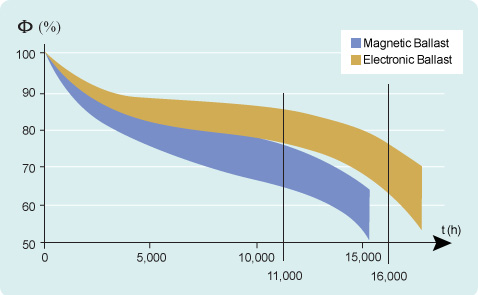APPLIANCES AND EQUIPMENT
Electronic Ballasts
In a fluorescent lighting system, the ballast regulates the current to the lamps and provides sufficient voltage to start-up. There are two major types of ballast, namely, electromagnetic ballast and electronic ballast. Electromagnetic ballast is well-developed over couple of decades while electronic ballast is a relatively new technology. The latter employs transistors to alter mains voltage frequency into high-frequency AC, taking advantage of the higher efficiency of lamps operated with higher-frequency (typically over 20 kHz) current. Compared to the one operating at normal power frequency, nearly 10% rise in efficiency is expected at a frequency of 10 kHz.
Conventional electromagnetic ballast with starter switch

A typical electronic ballast

Compared to conventional ballast, electronic ballast is more flexible since it allows more than one lamp to be fitted to a single ballast. In addition, the electronic ballast has no copper windings, it has smaller power losses and longer service life (i.e. lower light output depreciation). It generates less heat to the indoor space thus lowers the cooling load on air-conditioning.
Light output depreciation (Φ) for fluorescent lamps using conventional (magnetic) and electronic ballast.

Below is a summary on the typical energy saving performance using electronic ballast.
|
|
|
||
| Fluorescent lamp | 18W (600mm/2ft.) |
36W (1200mm/4ft.) |
58W (1500mm/5ft.) |
| Typical system power with Conventional Ballasts | 30W | 48W | 70W |
| Typical system power with Electronic Ballasts | 20W | 36W | 56W |
| Lighting circuit power saved | 10W | 12W | 14W |
| % lighting energy saved | 33% | 25% | 20% |
| Monthly energy saved assuming 10 hour/day | 3kWh | 3.6kWh | 4.2kWh |
| Monthly cost saving assuming $0.9/kWh | $2.7 | $3.2 | $3.8 |
|
|
|